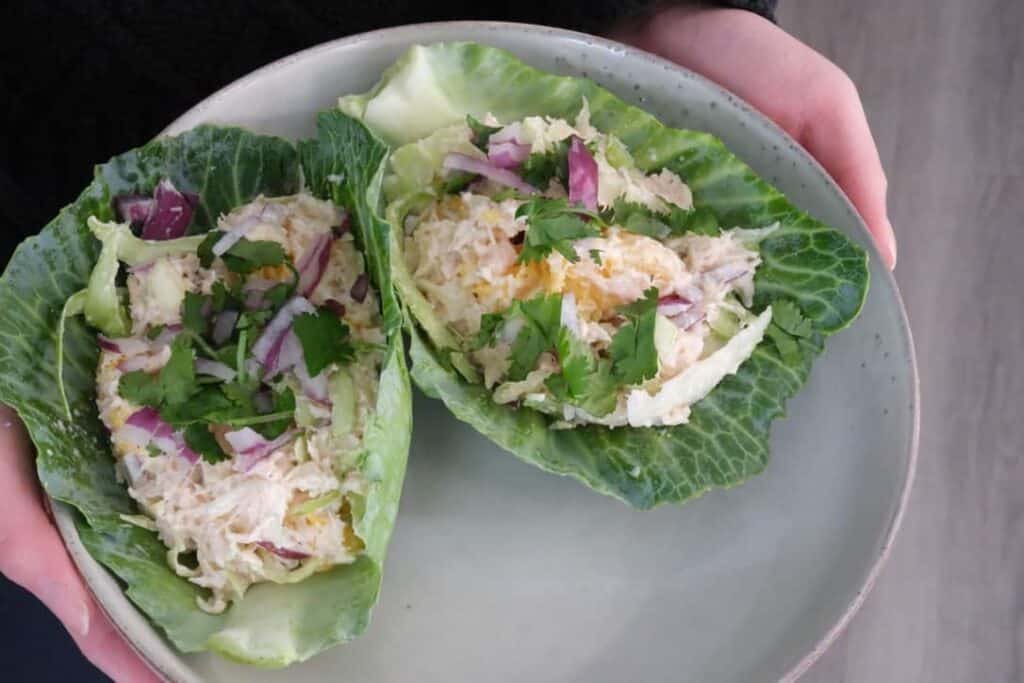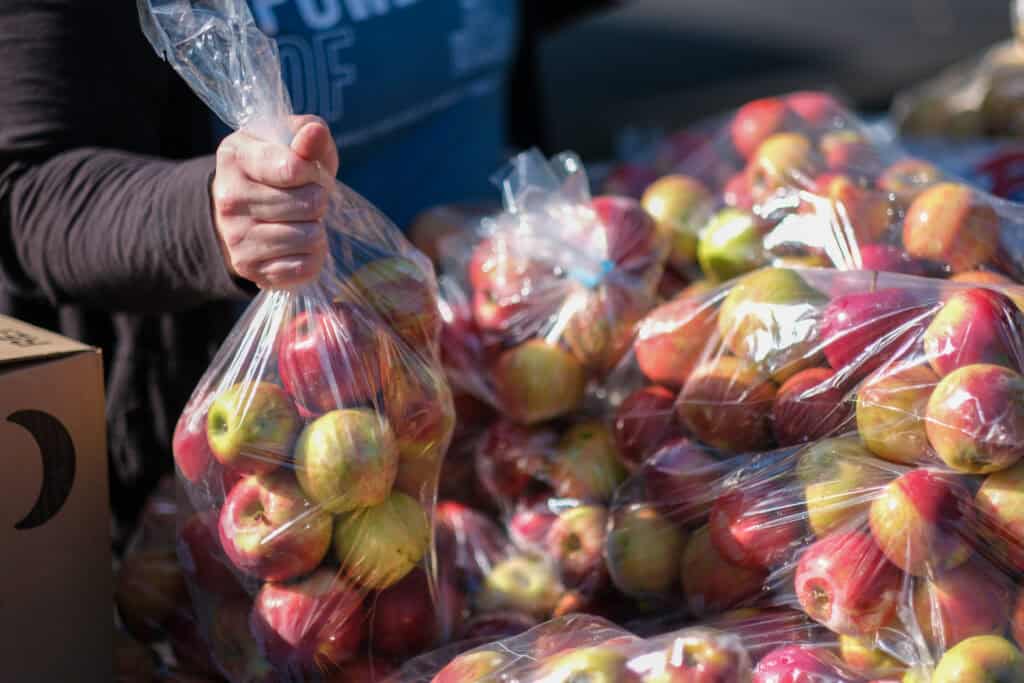Need food? Find resources in your neighborhood

Balanced nutrition is important for fueling your day, preventing sickness, and living a full life. Shake up your typical menu options with healthy recipes that taste great and learn some nutrition tips that help you feel great, too.
The food we consume plays a crucial role in our health, influencing everything from energy levels to the risk of chronic illnesses such as heart disease, diabetes, and obesity. A balanced diet rich in nutrients supports overall well-being and helps minimize these health risks.
We believe that supporting neighbors with nutrition education is an important part of providing food for a lifetime. When you eat balanced, healthy foods, you’re supporting your overall health and wellbeing long-term. Second Harvest Food Bank is here to ensure every person in our community has consistent access to the food they need to stay healthy.


Our team has complied a Diabetes Friendly Nutrition packet for our neighbors so you can feel empowered and thrive! Click below to download now.
Always wash your apples before preparing or eating them.
Eat apples with or without the peel based on your individual preference or the recipe you’re preparing. The peel is a great source of fiber.
Try apples in a variety of different ways:
To extend the freshness of an apple, store it in the refrigerator away from other strong-odor foods. It can store in the refrigerator for up to 3 weeks.
To prevent sliced apples from turning brown, dip them in a mixture of lemon juice and water, then store in the refrigerator.
Apples can be stored at room temperature for up to 1 week.
Apples are an excellent source of fiber, which can support digestion, help lower cholesterol levels, and control blood sugar.
Apples are high in Vitamin C, which is an antioxidant that supports the immune system.
Cinnamon Apples
Ingredients:
Directions:
Always wash your artichokes before preparing or eating them.
To prepare, first cut off the tips of the leaves. Next, cut off the top of the artichoke, and remove any small leaves at the base. Artichokes turn brown very quickly, so add lemon juice to any cut surface to prevent discoloration.
To store in the refrigerator, cut a dime width off the stem and sprinkle with water. Refrigerate in a sealable plastic bag. Use refrigerated artichokes within 5-7 days.
Once the artichokes are cooked, you can freeze any leftovers for up to 8 months.
Artichokes are an excellent source of fiber, which can support digestion, help lower cholesterol levels, and control blood sugar.
Artichokes are a good source of antioxidants, which may protect you from heart disease and cancer.
Steamed Artichokes
Ingredients:
Directions:
Always wash your asparagus before preparing or eating them.
After you wash your asparagus, trim away the tough ends.
You can have asparagus raw or cooked using many different methods such as steaming, sautéing, roasting, or grilling.
Trim the ends of the asparagus and place in a jar with 1-2 inches of water at the bottom. Cover with a plastic bag and store for up to 4 days in the refrigerator.
You can wrap your asparagus in a damp paper towel and place in a plastic bag.
Asparagus is an excellent source of fiber, which can support digestion, help lower cholesterol levels, and control blood sugar.
Asparagus is high in vitamins and minerals such as vitamin K, thiamine, riboflavin, and folate.
Oven Roasted Asparagus
Ingredients:
Directions:
Bananas can be eaten in a variety of different ways:
You should store bananas at room temperature out of direct sunlight.
To speed up the ripening process, bananas can be stored in a brown paper bag or placed near a ripe fruit (e.g., tomato).
If bananas start to turn brown, you can mash them up and use them in baked goods or you can freeze for later use.
Bananas are an excellent source of fiber, which can support digestion, help lower cholesterol levels, and control blood sugar.
Bananas are a good source of potassium, magnesium, and vitamin C.
Banana Peanut Butter Toast
Ingredients:
Always wash your broccoli before preparing or eating.
Slice through the middle of the broccoli stem, cutting close to the crown. The crown should break forming large florets.
Try broccoli in a variety of different ways:
Broccoli is best stored fresh and unwashed. To best store broccoli, wrap in a damp paper towel and store in the refrigerator for 2-3 days.
You can freeze chopped broccoli in a sealable plastic bag for up to 1 year.
Broccoli is an excellent source of Vitamins C and K. Vitamin C helps support a healthy immune system, while Vitamin K helps with bone and tissue health.
Roasted Broccoli
Ingredients:
Directions:
If preparing medium-long grain brown rice, use the
ratio of 2 & 1/2 cups of water/broth to 1 cup of rice. Rice should simmer for at least 45 minutes and then rest off heat for 10-15 minutes.
Dry brown rice can be stored at room temperature
for up to 6 months.
Once brown rice is cooked, it can be stored in the
refrigerator in a sealable container for 4-6 days, or
you can freeze and reheat when needed.
Brown Rice is an excellent source of fiber, which
can support digestion, help lower cholesterol
levels, and control blood sugar.
Brown rice is a good source of magnesium,
phosphorous, thiamine, and other key nutrients.
Black Beans and Brown Rice
Ingredients:
Directions:
Heat oil in a saucepan over medium-high heat. Add onion and garlic. Stir in rice
to coat.
Add broth and bring to a boil. Cover, reduce to a simmer, and cook until liquid is absorbed.
Stir in beans and cumin.
Always wash your carrots before preparing or eating.
Try carrots in a variety of different ways:
If your carrots have leaves, remove before storing.
To store carrots most effectively, store in the
refrigerator in water for up to 1 week.
Carrots are excellent sources of vitamin A, which is
an essential nutrient for eye sight, skin, and tissue
health.
Simple Roasted Carrots
Ingredients:
Directions:
Preheat the oven to 400 degrees F.
Cut carrots in half lengthwise.
Mix them in a bowl with the
oil, salt, and pepper.
Transfer to a baking sheet and roast in the oven for ~ 20 minutes.
Always wash and cut the ends of your cucumbers before preparing or eating.
Cucumbers can be eaten with the skin intact or removed depending on your personal preference.
Cucumbers are mostly eaten raw either as a component in a salad or by themselves as a snack or side dish.
To store in the refrigerator, wrap cucumbers in plastic wrap or in a plastic bag to help retain moisture.
You can store for up to 7 days.
Cucumbers are 96% water, which can help hydrate you.
Cucumbers are a good source of vitamin C, which is an important antioxidant and helps with immune support.
Cucumber Onion Salad Recipe
Ingredients:
Directions:
Canned chickpeas should be drained and rinsed prior to eating or cooking. You can eat chickpeas straight out of the can or heated up.
Try chickpeas in a variety of different ways:
Canned, unopened chickpeas can be stored at room temperature and can last an upwards of 3 years.
Chickpeas can also be stored in the refrigerator in a sealable container for up to 4 days.
To freeze chickpeas, drain any liquid and dry completely. Lay chickpeas flat in a sealable plastic bag and freeze for 1 year.
Chickpeas are a plant-based protein that are packed with nutrients including folate, iron, and phosphorous.
Chickpeas are good sources of fiber, which can aid in healthy digestion, and may help lower cholesterol levels and control your blood sugar.
Roasted Chickpeas and Vegetables
Ingredients:
Directions:
Always wash your collard greens before preparing or eating. You may have to scrub the leaves to remove any extra dirt.
Collard greens can be cooked in a variety of different ways. Try them sauteed, blanched, or cooked in the oven.
Unwashed collard greens can be stored in a damp paper towel in the refrigerator for 3-4 days.
To freeze collard greens, you will want to first wash them and cut off the stems. Next, place them in boiling water for 3-4 minutes, then cool using an ice-water bath. Place in a sealable plastic bag and remove any air; freeze for up to 1 year.
Despite collard greens being low calorie, they pack a punch when it comes to nutrients. Collard greens are an excellent source of vitamin K which helps with building healthy bones and helps with blood clotting when an injury occurs.
Quick Collard Greens
Ingredients:
Fresh corn can be cooked using many different methods such as boiling, grilling, or microwaving. If microwaving or grilling, corn can be cooked with the husk attached, or if boiling it can be cooked with the husk and silk removed.
Fresh corn can be stored in the refrigerator with the husk attached for up to 3 days. To extend the shelf life of fresh corn, place in a plastic bag, this will help the corn from drying out.
Cooked corn can be removed from the cob and frozen for up to 1 year.
Corn is an excellent source of thiamine (B1) and folate.
Microwave Corn on the Cob
Ingredients:
Always wash your eggplant before preparing or eating.
Cut off the ends of the eggplant. Peeling the skin is optional.
Eggplants are typically enjoyed using one of many different cooking methods such as steaming, baking, and sauteing.
A whole eggplant can be stored at room temperature for up to 4 days but should be kept out of direct sunlight.
Eggplant can also be stored in the refrigerator for up to 1 week, preferably in the crisper drawer. You should wrap your eggplant in a damp paper towel and place in an unsealed plastic bag for best results.
Eggplants are an excellent source of fiber, which can support digestion, help lower cholesterol levels, and control blood sugar.
Eggplants are also high in vitamin C, which helps with immune support, and vitamin B6, which helps keep your immune and nervous system healthy.
Garlic Baked Eggplant
Ingredients:
Directions:
Always wash your kale before preparing or eating.
You can use kale in a variety of different ways:
To store kale in the refrigerator, wrap in a damp paper towel and place in a plastic bag. Store for up to 5 days.
You can freeze whole kale leaves by placing them into a sealable plastic bag (remove any moisture) and transfer to the freezer. Kale should keep for up to 12 months.
Kale is packed with vitamins and minerals including vitamin A, C, K, and vitamin B6. Kale is also a good source of potassium, calcium, iron, and manganese.
Garlic Baked Kale
Ingredients:
Directions:
For dry lentils, first rinse and remove any pebbles or debris. Combine 3 cups of liquid (water or broth) with 1 cup of dried lentils in a saucepan. Bring to a boil, and then let simmer until lentils are soft. Strain the lentils and add any desired seasonings.
Dry lentils can be stored indefinitely at room temperature.
Cooked lentils can be stored in the refrigerator for up to 1 week.
You can freeze cooked lentils for up to 6 months in a sealable plastic bag or container.
Lentils are a good source of folate and iron.
Lentil Tacos
Ingredients:
Directions:
Oats should be cooked according to their package. In general steel-cut oats take around 28-30 minutes to cook, while instant oats take 1-2 minutes.
Try oats in a variety of different ways:
Dry oats should be stored in a cool, dry place.
Cooked oats should be placed in a sealable container and refrigerated until ready to eat.
Oats are whole grains and are an excellent source of fiber, which can support digestion, help lower cholesterol levels, and control blood sugar.
Oats are also good sources of thiamine and manganese.
Vanilla Overnight Oats
Ingredients:
Directions:
Chop off both ends of the onion and peel off 2-3 layers of skin.
Depending on the type of recipe you’re preparing, you may need to chop or slice the onion.
Try onions in a variety of different ways:
Onions are best stored in a cool, dry place (e.g., a kitchen pantry).
If onions are peeled, they can be stored in the refrigerator for 10-14 days. If sliced or chopped, they can be stored in the refrigerator for 7-10 days.
Onions are a good source of vitamin C, which is an important antioxidant and helps with immune support.
Onions also have anti-inflammatory properties.
Baked Onion Rings
Ingredients:
Directions:
Always wash the outer layer of the orange before cutting.
To cut an orange, first cut in half, and then cut the 'half' in half so that you have 4 quarters.
You can also just peel off the outer layer and eat as is.
If you plan on eating your oranges within a few days, you can store them at room temperature, but keep them out of direct sunlight.
If you don't plan on eating your oranges right away, store in the refrigerator for up to 1 month.
Cut oranges should be stored in an airtight container in the refrigerator. Eat within 3-4 days.
Oranges are excellent sources of vitamin C, which helps with immune support, and potassium, which is important for kidney and heart function, and muscle contractions.
Orange Banana smoothie
Ingredients:
Directions:
To prepare a pineapple, first cut off the stem and the end. Stand the pineapple up, then slice off the skin and rotate per slice. Cut the pineapple into pieces around the center. The center is known as “the core” and you can throw this part away.
You can store whole, uncut pineapple at room temperature for 2 days or in the refrigerator for up to 4 days.
To freeze pineapple, cut into chunks and place in a sealable container and freeze for up to 1 year.
Pineapples are excellent sources of both manganese and Vitamin C.
Overnight Pineapple Banana Oats
Ingredients:
Directions:
Always wash your rutabagas before preparing or eating.
Remove the tops from your rutabagas and peel using a sharp knife.
Try rutabagas in a variety of different ways:
Rutabagas are best stored in the refrigerator and can be kept for up to 2 weeks. If storing at room temperature, rutabagas can be kept for up to 1 week.
If you want to freeze your rutabagas, first wash and remove the tops. Then peel, cut into cubes and place into boiling water. Cook for 3 minutes, drain, and place into an ice-water bath. Dry the rutabagas and store in the freezer for up to 1 year.
Rutabagas are good sources of vitamins A and C, which play an important role in immune function.
Baked Rutabagas
Ingredients:
Directions:
Always wash your spinach before preparing or eating.
Try spinach in a variety of different ways:
Spinach is best stored in the refrigerator in a sealable container and can be kept for 4-5 days.
To freeze spinach, place in a sealable plastic bag and place into the freezer. The Spinach should keep for up to 1 year.
Spinach is an excellent source of fiber, which can aid in healthy digestion, and may help lower cholesterol levels and control your blood sugar.
Spinach is a good source of iron and vitamin A.
Strawberry Spinach Smoothie
Ingredients:
Directions:
Before slicing, wash the outside of the watermelon. Use a sharp knife to cut off the bottom of the rind. You can then slice into pie-shaped pieces or however you like.
Try watermelon in a variety of different ways:
Uncut watermelon can be stored at room temperature, for example, on a countertop.
To freeze watermelon, cut into small pieces and place on a baking sheet to flash freeze for 1-2 hours. Then, place in a sealable plastic bag and freeze for up to 8 months.
Watermelon is a great hydration source as they consist of 92% water.
Watermelon is also an excellent source of vitamin A and C, and vitamin B6.
Watermelon Feta Salad
Ingredients:
Directions:
Always wash your yellow squash before preparing or eating.
Yellow squash can be eaten raw or cooked using a variety of different methods such as sauteeing or roasting.
Yellow squash can be stored in the refrigerator for 3-5 days.
Yellow squash can also be cut up and frozen. To do this, place in a pot of boiling water for 3 minutes and then immediately transfer to cold water. Freeze for up to 1 year.
Yellow squash are good sources of Vitamins C, B6, and manganese.
Baked Parmesan Yellow Squash
Ingredients:
Directions:
Always wash your zucchini before preparing or eating.
Peeling zucchini is optional and based on your personal preference or the recipe you are preparing.
Zucchini can be eaten raw or cooked using a variety of different methods such as sauteeing or roasting.
Zucchini can be stored in the refrigerator for 1-2 weeks.
Zucchini can also be cut and frozen for up to 3 months.
Zucchini is an excellent source of fiber, which can aid in healthy digestion, and may help lower cholesterol levels and control your blood sugar.
Zucchini is full of other key nutrients such as vitamins A, C, K, and folic acid.
Sauteed Zucchini with Parmesan
Ingredients:
Directions:
Heat the oil and butter in a skillet over medium-low heat. Cook until the onions are brown (~10 minutes). Add in the zucchini with
salt and pepper.
Increase to medium heat and cook for an additional 10-15 minutes.
Your support helps your community thrive.
To provide the best experiences, we use technologies like cookies to store and/or access device information. Consenting to these technologies will allow us to process data such as browsing behavior or unique IDs on this site. Not consenting or withdrawing consent, may adversely affect certain features and functions.